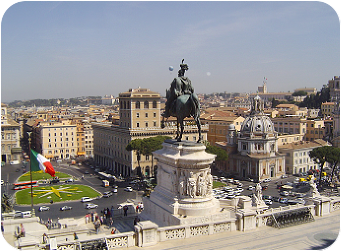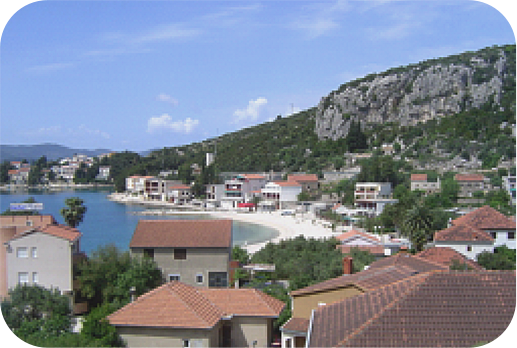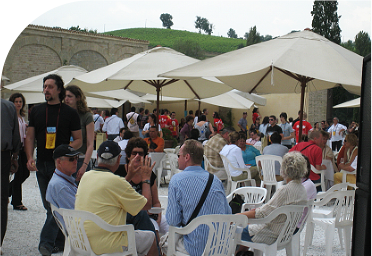Tales of Big Julie and Foraging the Forum There is something about pondering the Forum…
Umbria Uncorked
Download a PDF Version of this article

Crank up the trusty diesel hire car for today is the 15th of May and the Ceri Festivale at Gubbio. This annual event is a prime example of the festivo of the fervent as 3 cabals shunt a top heavy cradle of candles drunkenly about the town. The Italian attitude of historical event preservation is a catalyst for fatuous festivales forever preserving the local tourist industry.
The Red & Yellows, Red & Blue and Red & Black teams from 3 parts of Gubbio had a sprawling series of shunts in a quasi-religious manner. Viewing for the agnostic means one can only admire the manic fervour attached to the ceremony laden with Catholic overtones. The crowds were shouting and rushing down cobblestone alleys tipping the giant statues into upstair windows to gain the blessings of supporters. The kaleidoscope of merging colours with the red scarves added to the carnival of candles. Who cares who wins the race when the front running handicap of last year’s winner enables them to thwart the passage of the less fortunate team’s.
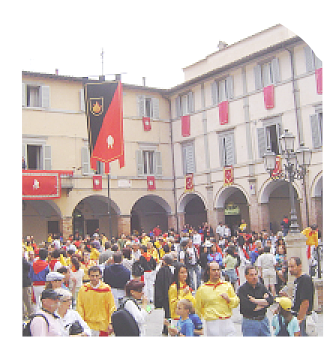 Gubbio also hosts a battle of the street brass bands amid jostling supplicants the bands promenade along the tight streets blasting hooting and trumpeting whilst trying to musically out muscle each other. The sounds resonated through the high walls taking on a loud persona of raucous Mardi gras participants. The streets were alive with the triptych of the cantonatos and the moving local participants did not interface with the fawning tourists.
Gubbio also hosts a battle of the street brass bands amid jostling supplicants the bands promenade along the tight streets blasting hooting and trumpeting whilst trying to musically out muscle each other. The sounds resonated through the high walls taking on a loud persona of raucous Mardi gras participants. The streets were alive with the triptych of the cantonatos and the moving local participants did not interface with the fawning tourists.
The wreath of brickwork is overwhelming and the need to spontaneously join in is helped by the open wine bars or entocea. Whole baked wild boar served with panninos doused with the local Rossi was available at every cafe. The proprietor of our first wine shop was aware of the need for plastic glasses and napkins and packed it to travel.
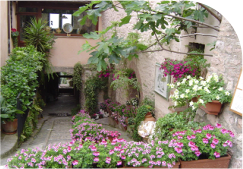 A stagger up imposingly steep cobbled walkways to the Museo on a plateau above the town led to a bounteous setting. Grass squares with trimmed hedgerows, crowded with Italian revellers picnicking on the manicured lawns. The view over Gubbio with the sounds of deoxygenated Brassery created an endearing memory of the Ceri Festivale.
A stagger up imposingly steep cobbled walkways to the Museo on a plateau above the town led to a bounteous setting. Grass squares with trimmed hedgerows, crowded with Italian revellers picnicking on the manicured lawns. The view over Gubbio with the sounds of deoxygenated Brassery created an endearing memory of the Ceri Festivale.
The red at E6.50 was as good as it gets plus the chunks of boar had both crackling and body pieces attached. A Gargantuan feast held in an atmosphere of medieval magnificence incongruously tenanted by the clergy.
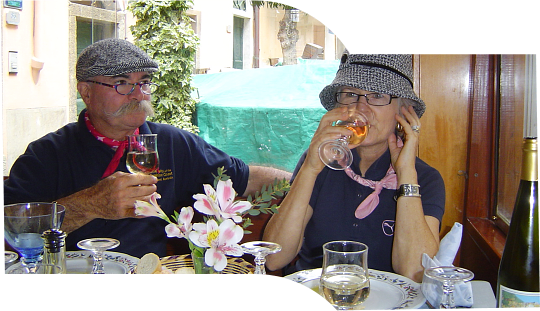 The town was left well in the shadow of celebration and the pathways were strewn with revellers as the heavy “Ceri” Statues still tottered about. The length of daily sunlight and no pressure to succumb to the delights of calorie overkill meant a stop at perhaps Assisi was on the agenda.
The town was left well in the shadow of celebration and the pathways were strewn with revellers as the heavy “Ceri” Statues still tottered about. The length of daily sunlight and no pressure to succumb to the delights of calorie overkill meant a stop at perhaps Assisi was on the agenda.
The vagaries of Italian sign posting prevailed upon our limited cartographical ability and somehow a torturous route to Perugia prevailed. Assisi was lost and Spello was found.
Spello is a pristine, houseproud competent operation and history treated this town well. It helps to have the template right but the inhabitants have made Spello to last.
The tourist shops had service slickness, business savvy ,and a touch of class all without taking away the fairytale. The walk is steep from bottom to top but a solicitous stop for a gelato at Bar Giardino on Via Garibaldi 10 is full of surprises. The price of a good expresso or gelato enables one to wander into the garden to rare Italian table service plus an adjunct to the commercial operation is a view to die for stretching over the Umbrian countryside. This is a cheap opportunity to take ones own postcard picture, get knocked over by the view, whilst musing the inequities of overpriced Roman pavement dining.
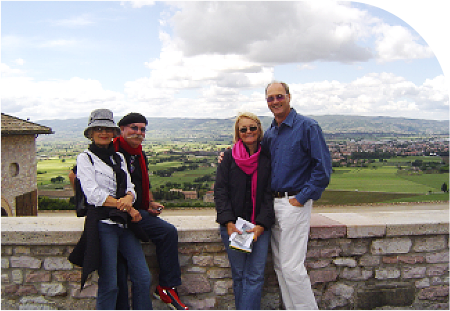 This corporeal inactivity is not going to prevail and Bevagna at the start of the rise to the hilltops beckons to be explored. This is a village that looks like a setting in a rumplestiltskin tale with a moat like river surrounding fairytale walls. An easy access carpark outside the walls allows entry through the original gates. It was a quiet start due to siesta time as the tight people free streets took on the persona of the Village of the Dammed.
This corporeal inactivity is not going to prevail and Bevagna at the start of the rise to the hilltops beckons to be explored. This is a village that looks like a setting in a rumplestiltskin tale with a moat like river surrounding fairytale walls. An easy access carpark outside the walls allows entry through the original gates. It was a quiet start due to siesta time as the tight people free streets took on the persona of the Village of the Dammed.
This is a town, which behoves making a friend, as surely not a lot else seems to be going on. Every small village is in the eye of the beholder and the memories are gauged by complimentary activities that happen. This place can be circumnavigated in an hour or two and has good makings for a quiet holiday with a group of like-minded participants.
The short Bevagna perambulate is over and the road across the valley to Trevi looms next on the agenda. There is an ulterior motive in this route as a search for the elusive Italian Mall to top up supplies is required. The shopping at the Folognia/Trevi “Wonderful” Supermercato is notable for its ordinariness and abysmal shopping. Italians do not do Malls well perhaps they could be renamed Mauls? The plight of the small shop owner in Italy is alleviated by the fact that pensions are augmented by many small family businesses and shopping centres are not wanted.
Trevi is yet again another walled monument to the Papal pilgrim trail which has stood the test of time. This is another village that perhaps needs a guided tour to elucidate its characteristics and reveal the hidden treasures. To stop in rambling fashion at the end of a day is not conducive to exploratory memories. The obligatory stop for espresso and to inveigle yet another unpaid toilet stop into the cost is never far from the psyche.
Public toilets are an anathema to the bladder deprived and Italian public amenities are no competition due to extinction. A walk through Trevi’s tight streets cause the stomach to be drawn in as the Smart Car set rark through the alleys without fear of retribution.
The ubiquitous dominant Church Square is a stamping ground for the aficionados of Italian idolatry and one wonders if anybody works. Tick and another village has had the flick as the road to Spoleto beckons.
The Trevi road along the S3 to Spoleto leads through the neoclassical outskirts of a nondescript perimeter town. Ugly modern suburbs leading in to the Piazza Garibaldi (every town has one of these) before heading uphill into the old town true. Spoleto has a commercial bent that is less enchanting than the smaller villages but still manages to close meals off at 3.00pm. The view from the Piazza Liberta onto the Roman Amphitheatre offsets the ordinariness of a badly made Panini nearby.
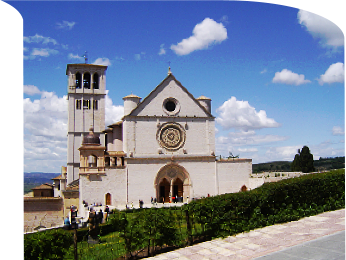 The town is like a construction camp and a scramble into the alleys left a dry throat and an exposure to sacking cloth syndrome. The dispensing of Tartufo (truffle) is clearly competitive but the prized white was readily available to stash in the dilly bag. The town is a hotch potch of streets and high buildings reaching up the hillside with a need for local knowledge and a cut lunch.
The town is like a construction camp and a scramble into the alleys left a dry throat and an exposure to sacking cloth syndrome. The dispensing of Tartufo (truffle) is clearly competitive but the prized white was readily available to stash in the dilly bag. The town is a hotch potch of streets and high buildings reaching up the hillside with a need for local knowledge and a cut lunch.
Each village is an experience and tourists will be glad of the sanctuary of the agritourismo retreat and a foot wary homecoming. Everyday brings another foray into the countryside to yet another petite facsimile of every “Under Tuscan Sun “. Village in situ. Assisi is the jewel of religious tourism outside of Rome and should be avoided at any cost during the European and American holidays. Perhaps St Francis would harbour a smirk if he could see the crass memorabilia being sold at his blessed site. This town in the quiet times is worthy of any stopover and the best entry is to drive into the top via the meandering and spectacular road.
The restoration after the earthquake in the late 1990s is world class and it is hard to imagine the destruction as it was. For the purveyors of footwear one can even view the original Assisian sandal circa St Francis. The village has spectacular ramparts that perch above the valley of the main pilgrim march.
Walking through many levels reveals a pert piazza with even a Hollywood style Roman temple that looks like Charlton Heston’s anteroom. This is the part of Umbria that has been assaulted by the ubiquitous Lotobus tourist so times of visitation need to be monitored.

